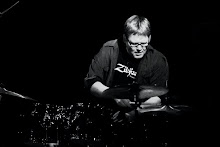Today I want to talk about changing the implements we use to play the drums, specifically in the course of a tune in progress. The most common "switch" is from brushes to sticks, although there are many more possibilities.
This is the sort of thing that a lot of drummers just assume it will "come together" somehow. I know in my case it was something I had to think about and work on a lot.
An interesting aspect of changing implements is it's something that a lot of non-drummers notice. They are particularly aware of it when it doesn't go well, perhaps due to the sudden (and noisy, usually) change of texture that isn't smooth. I'm going to discuss some ways of working on this in today's blog.
1. As always, listen!
There are many examples of great drummers switching from brushes to sticks. Check out players such as Philly Joe Jones, Jimmy Cobb, and Tony Williams, to name a few. Also notice when the greats make the transition less than smoothly. Did you hear any extra stick clicks etc.? One thing you'll notice about implement transitions is that no one's record is spotless. Our goal is to make the majority of our switches smooth.
2. Where are you going to put your stuff?
An important factor is where you're going to put the implements you aren't using to make them easy to get at. All have advantages and drawbacks.
Shell of the bass drum? It's close, but can be hard to navigate on a 5-piece drum set. Also, bass drums vibrate a lot, and vibration causes movement. Your stick or brushes can go somewhere unreachable if you're not careful.
Music stand? Also close by, but can be noisy. Also if you are reading a chart that's more than 2 pages long they will be in the way of your music.
Floor tom? Close by and relatively stable but as long as something's on the drum, you can't use that sound.
Stick bag? Close by, but putting open brushes into it will ruin them.
Under your arms or legs? Again, it's close by but there's a possibility of inflicting great pain on yourself!
Again, you need to experiment in the practice room to find which methods work best for you.
3. You don't have to switch both hands at the same time.
Keep in mind, especially if you're playing swing, once the ride cymbal is going (in the case of a brushes to sticks switch) you don't have to comp on the snare immediately. The cymbal alone will sound full enough while you grab the other stick. And also......
4. It's unlikely your feet are switching.
I often like to think of the feet in an implement switch like so:

Or.....

pay no attention to the man behind the curtain, he's just trying to get his sticks out!
..Like a simple card trick, often when we're switching implements we're trying to take the viewer/listener's attention from what our hands our doing by creating a diversion, usually with out feet.
5. Give yourself time to make the switch.
If you haven't started to make a move at least a bar before it's supposed to happen, it probably won't end well. Get used to anticipating when your going to transition implements so you can get to the next section smoothly.
To conclude, here's a short example of me trading phrases between brushes and sticks. Trading (and actually soloing rather than keeping time) is a great way to practice our juggling act. It's much more challenging than the usual "one switch a tune' routine and gets us thinking about how to make the trades musical. A couple of notes. I start off trading 8s for a couple of choruses of "Think of One" by Monk, go to fours for a half chorus and finish off back to 8s. Notice sometimes I overlap the phrases a bit. This is okay as long as you keep the 4 or 8 bar structure. Also notice that some of my trades are noisier than others/ Remember, it's a favourable law of averages we're going for rather than perfection. Have fun!

This comment has been removed by a blog administrator.
ReplyDelete